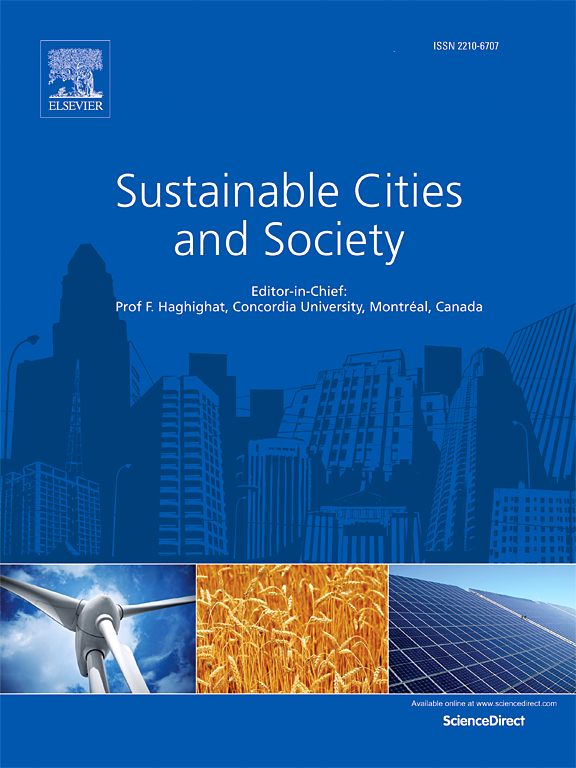Simulation of sustainable solar thermal storage system involving photovoltaic panel equipped with nanofluid-based splitter considering self-cleaning coating
IF 10.5
1区 工程技术
Q1 CONSTRUCTION & BUILDING TECHNOLOGY
引用次数: 0
Abstract
In this investigation, an improvement strategy for a photovoltaic (PV) system is examined, incorporating a nanofluid filter and a paraffin-based storage system. The utilization of a spectral filter, employing ZnO-water nanofluid, is intended to optimize the utilization of the entire spectral distribution of sunlight. In all scenarios, a paraffin layer is introduced, comprising RT25 mixed with ZnO nanoparticles. Moreover, the consideration is given to the influence of applying TiO2 nanoparticles for coating the upper glass layer. The investigation utilizes simulations based on the finite volume method and examines four unique scenarios: case 1, characterized by the absence of a filter; case 2, involving the incorporation of a nanofluid filter; case 3, incorporating dusty glass with a filter; and case 4, integrating a self-cleaning effect with a filter. Examining various performance metrics uncovers significant findings. The research showcases a 5.3 % rise in CO2 mitigation (CM) through the integration of a nanofluid filter, a 12 % reduction linked to the influence of dust, and an 11.2 % enhancement facilitated by a self-cleaning method. The presence of dust initially contributes to a decrease in outlet temperature of the filter (Tout), but eventually, it exhibits a 66.79 % improvement with the adoption of the self-cleaning method. The application of a coating on the glass layer leads to an 11.2 % boost in electrical performance (ηel). Utilizing filter results in a decrease of 19.08 % in temperature of paraffin (TPCM) and 8.54 % in liquid fraction (LF), while concurrently enhancing ηel by 5.03 % at t = 80 min. Three cities have been analyzed in terms of profit after 12 years, with Berlin showing the highest returns. For Berlin, implementing the spectral filter increases the system's profit by approximately 5.34 %, while coating the glass with nanoparticles further boosts it by about 18.12 %.
求助全文
约1分钟内获得全文
求助全文
来源期刊

Sustainable Cities and Society
Social Sciences-Geography, Planning and Development
CiteScore
22.00
自引率
13.70%
发文量
810
审稿时长
27 days
期刊介绍:
Sustainable Cities and Society (SCS) is an international journal that focuses on fundamental and applied research to promote environmentally sustainable and socially resilient cities. The journal welcomes cross-cutting, multi-disciplinary research in various areas, including:
1. Smart cities and resilient environments;
2. Alternative/clean energy sources, energy distribution, distributed energy generation, and energy demand reduction/management;
3. Monitoring and improving air quality in built environment and cities (e.g., healthy built environment and air quality management);
4. Energy efficient, low/zero carbon, and green buildings/communities;
5. Climate change mitigation and adaptation in urban environments;
6. Green infrastructure and BMPs;
7. Environmental Footprint accounting and management;
8. Urban agriculture and forestry;
9. ICT, smart grid and intelligent infrastructure;
10. Urban design/planning, regulations, legislation, certification, economics, and policy;
11. Social aspects, impacts and resiliency of cities;
12. Behavior monitoring, analysis and change within urban communities;
13. Health monitoring and improvement;
14. Nexus issues related to sustainable cities and societies;
15. Smart city governance;
16. Decision Support Systems for trade-off and uncertainty analysis for improved management of cities and society;
17. Big data, machine learning, and artificial intelligence applications and case studies;
18. Critical infrastructure protection, including security, privacy, forensics, and reliability issues of cyber-physical systems.
19. Water footprint reduction and urban water distribution, harvesting, treatment, reuse and management;
20. Waste reduction and recycling;
21. Wastewater collection, treatment and recycling;
22. Smart, clean and healthy transportation systems and infrastructure;
 求助内容:
求助内容: 应助结果提醒方式:
应助结果提醒方式:


